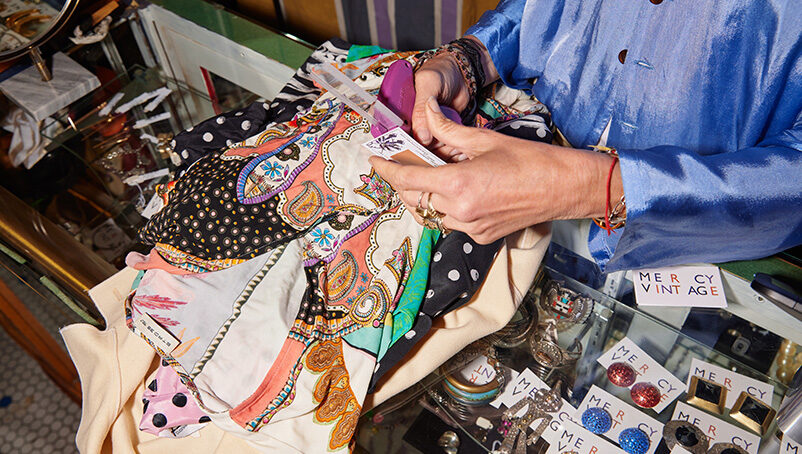1. Research and prepare to make an Etsy store
Opening an Etsy shop is easier than ever. However, before selling on Etsy, doing some initial research is essential to lay a solid foundation.
Identify your niche
Start by identifying what you’re passionate about and what you can create consistently. Whether it’s handmade jewelry, vintage clothing or digital prints, your niche should align with your skills and interests.
Once you’ve chosen your niche, analyze the market. Browse Etsy to see what similar products are available, what sells well and what product gaps you might fill.
Understand Etsy’s policies
Familiarize yourself with Etsy’s terms of service and seller policies to ensure you comply with the platform’s rules.
So, how much does it cost to sell on Etsy? It depends. Etsy has a fee structure. They charge a listing fee for each item and transaction and payment processing fees. There’s also other services you can opt into. Knowing these costs upfront will help you price your products effectively.
Etsy doesn’t require a business license to sell on Etsy, but depending on what you’re selling, your local laws may require it. Check your local business authorities for information.
Protect your online business with business insurance
Running an Etsy shop can be rewarding, but it also comes with risks that many sellers overlook. Business insurance can help protect your shop from unexpected events that could jeopardize your hard work.
E-commerce insurance typically covers a range of potential issues, including:
- Product liability. If a customer claims your product caused injury or damage, this coverage can protect you from legal and medical expenses.
- Business property damage. Whether you have equipment or store inventory at home or in a rented space, insurance can help cover losses due to fire, theft or other disasters.
- Business interruption: If an unforeseen event forces you to temporarily close your shop, this coverage can help replace lost income, allowing you to stay afloat until you can reopen.
Without insurance, one unexpected incident could lead to significant financial loss or even the closure of your shop. Investing in business insurance provides peace of mind and helps safeguard your Etsy business.
2. Set up your Etsy shop
Once you’ve done your research, it’s time to set up shop. Here’s how to make an Etsy store.
Set up your Etsy seller account
Your first step is to visit Etsy.com/sell and click “Get Started.” You’ll log in or create an Etsy seller account by entering your email, name and password. Alternatively, you can create your account by logging in with your Google, Facebook or Apple credentials.
Then, it’s time to set your shop preferences, such as your default language, home country, and currency. Etsy will also ask if you plan to be a full-time seller, part-time seller or other.
Choose your Etsy shop name
When learning how to get started on Etsy, naming your shop is one of the most exciting items on your to-do list. Get creative, but make sure it’s easy for customers to remember. Consider a name that reflects what you sell, but make sure it’s not too specific if you ever want to expand your product line.
Etsy has guidelines that your shop name must meet:
- 4-20 characters in length
- No spaces or special characters
- No profanity
- Not already in use by an existing Etsy member
- Does not infringe on another’s trademark
If you’re stuck on what name to choose, consider descriptive names (PinkTulipCandles, RusticAndNatural) or your own name (DIYbySteph, ChloeCrafts).
Customize your shop
Customizing your shop’s appearance is essential for making a strong first impression. Start by writing a compelling shop description that tells customers what your shop is all about.
Next, upload a shop banner and logo that visually represents your brand. Additionally, use the shop announcement section to share important updates or promotions with your visitors.
Finally, create an FAQ section to answer common questions about your products, shipping, and return policies.
3. Create your first product listing
Now that your shop is set up, it’s time to figure out how to sell items on Etsy.
Create helpful and accurate product descriptions
To create a listing, click “Add a listing” (or tap the + icon if you’re on the app) and follow the prompts.
Start with a clear, descriptive product title with keywords buyers might use when searching for your item. You’ll also want to:
- Add photos and video
- Add a description and listing categories
- Include the quantity you have available and the selling price
- Set up shipping options
- Decide if you want to run an Etsy Ads campaign
- Publish (or save) your listing
Etsy’s step-by-step guide gives you a more detailed look at creating a listing.
Etsy lets you list physical and digital items; the process is slightly different for each option. Follow these steps to add physical items, but visit Etsy’s guide to list a digital item.
Once you have at least one product listing, you can officially open your shop. Click “Open Your Shop” to make it happen.
Take great photos of your products
High-quality photos are crucial for showcasing your products. Use natural light and a clean background to make your items stand out. It’s helpful to include multiple photos from different angles to give buyers a complete view of your product.
Editing your photos to enhance brightness and contrast can make them more appealing, but avoid over-editing to the point where the product looks different from reality.
Price your products competitively
Pricing can be tricky, but it is important to balance competitiveness and profitability. Research what similar items are selling for on Etsy and consider your costs, including materials, time and Etsy fees. Also, think about how shipping costs will affect your pricing strategy. You might offer free shipping to attract more buyers, but you will need to include the costs in your product price.
Make your store easy to find
Using search engine-optimized keywords on Etsy can help your listings appear in search results. Think about what a customer might type into the search bar and use those terms in your item descriptions and titles.
Tags and categories also play a vital role in helping your products get found on Etsy. Use all the available tags to include relevant keywords that describe your product. Choose the most accurate category for your listing to ensure it appears in the right searches.
4. Get paid through Etsy
Getting paid on Etsy is simple, thanks to Etsy Payments, the platform’s integrated payment system. With Etsy Payments, customers can use various methods, such as credit cards, PayPal, Apple Pay and more.
To set it up, you’ll need to provide the following:
- Bank account: This is where your earnings will be deposited
- Personal information: Etsy requires basic information like your full name, address and sometimes a government-issued ID for verification. This step helps Etsy ensure the platform’s security and compliance with regulations.
- Tax information: Depending on your location, Etsy may require you to submit tax-related information, such as a taxpayer identification number (TIN) or a social security number (SSN) in the U.S. Etsy will use this information to generate tax documents, if applicable, at the end of the year.
Etsy handles all transactions, deducting any applicable fees before depositing the remaining balance into your account. You can choose how often you want to receive payments — daily, weekly, biweekly or monthly.
Once a sale is made, Etsy processes the payment, deducts fees and transfers the funds to your account based on your chosen deposit schedule. Etsy Payments streamlines the process, allowing you to focus on running your shop while they handle the financial side.
5. Set up shipping and handling
Shipping is a key part of the customer experience, so it’s important to get it right.
Setting up shipping profiles
Etsy allows you to create shipping profiles that you can apply to multiple listings, saving you time and ensuring consistency. Consider your shipping options, including whether you’ll offer domestic and international shipping. Set clear shipping rates and processing times to manage customer expectations.
Packaging your products
Proper packaging is essential for protecting your items during transit. Use materials that are appropriate for the product to prevent damage. Additionally, consider adding a personal touch to your packaging, such as branded materials or a thank-you note, to enhance the unboxing experience.
Handling orders
Once you start receiving orders, it’s important to process them promptly. Keep your customers informed about their order status by marking items as shipped and providing tracking information if available. Good communication is vital, so if there’s any delay or issue, let the customer know immediately and offer solutions.
6. Advertise and promote your Etsy shop
Marketing is crucial for driving traffic to your Etsy shop and attracting buyers.
Promoting on social media
Social media is a powerful tool for promoting your Etsy shop. Platforms like Instagram and Pinterest are especially effective for visually showcasing your products. Create accounts specifically for your shop and post regularly to build a following.
Engage with your customers by responding to comments and messages and consider running contests or giveaways to increase your reach.
Etsy ads
Etsy offers its own advertising platform where you can promote your listings within the marketplace. Start with a small budget and test different listings to see which perform best. Monitor your ad performance regularly and adjust as needed to maximize your return on investment.
Build customer loyalty
Building a loyal customer base can lead to repeat sales and positive word-of-mouth. Encourage customers to leave reviews by following up after a purchase and offering incentives like discounts on future orders.
Respond to positive and negative reviews to show that you value customer feedback. Consider offering special promotions or discounts to repeat customers as a way to show your appreciation.
You can also visit the Etsy Help Center for more guidance on making your store a success.
7. Manage and maintain your Etsy business
Running an Etsy shop requires ongoing management to ensure success.
Track sales and finances
Etsy provides built-in analytics tools that help you track your shop’s performance, including views, favorites and sales. Use this data to understand what’s working and where you can improve.
It’s also important to keep accurate records of your income and expenses for tax purposes. Consider using accounting software or hiring a professional to help manage your finances as your business grows.
Provide great customer service
Excellent customer service is key to maintaining a good reputation on Etsy. Respond to customer inquiries as quickly as possible, and be polite and professional in all your interactions.
If a customer has an issue with their order, address it promptly and offer a solution, whether a refund, replacement or something else. Happy customers are likelier to leave positive reviews and recommend your shop to others.






